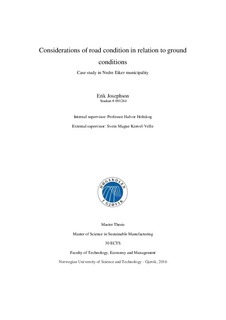| dc.description.abstract | This study concludes that the municipal road network in Nedre Eiker has a large maintenance backlog. There are many critical damages on the roads that should be repaired immediately. This study looked at the prevalence of damages in relation to ground conditions. Municipal roads in Nedre Eiker were used as a case in this work, and the study concludes that there are four prominent types of injuries that occur in 4 different soil conditions. The 4 damage types are cracks, crazing, desiccation and patching. The 4 different zones with soil conditions are zone 41 (Ocean and fjord deposition, continuous cover, often with large thickness), 50 (River and stream deposition), 72 (Weathering Material, incoherent or thin cover over the bedrock) and 120 (Filling material (anthropogenic material)) from the maps from Norges Geologiske Undersøkelse. Through literature search, data collection and analysis, and evaluating results against the literature, this study shows that the proven damage is related to the ground where the road is built. Using the available literature, the study proposes what measures will be most sustainable, efficient and economical for the roads. The measures are as follows: Soil zone 41: The zone contains frost hazardous materials, and the best action would be to build up the road again with a new substructure. The costs can be kept down if some work can be performed in combination with water and sewer upgrade. An effective drainage can extend the life of the asphalt surface, but will not eliminate problems with frost. Soil zone 50: The zone contains a lot of sand and gravel, which suggests that a good drainage will be able to extend the road life. In addition, it will be effective to lower the groundwater level whenever possible. Soil zone 72: The zone contains a thin incoherent layer weathering material. An efficient drainage system could extend its lifetime. Construction of a new thick substructure will probably have a poor benefit / cost. Alternatively, it could pay off with a thin supporting layer under the asphalt surface if the road will be dug up for other reasons. Soil zone 120: This is a zone which may contain many different soil qualities. This area must be carried out geological surveys to determine the best actions. But drainage is an action that always will provide an improvement, so this will give (small) gains if there is no economy to greater improvements and sampling. This report concludes finally that there are effective solutions to road maintenance even though the road is built on a poor foundation. An extended study can find good solutions for several types of soils and ground conditions than is presented in this report. The Norwegian road network represents great values that require continuous monitoring and maintenance to maintain the desired quality. Since municipalities as road owner often have limited resources, it is important to prioritize measures where these provide the greatest economic benefit. Many of the municipal roads in Norway is in poor condition, probably both because of the bad economy and lack of expertise at the time these roads were established. The results presented in this thesis is arrived at through an extensive registration of damage to municipal roads in Nedre Eiker, study of maps from Norges Geologiske Undersøkelse, Statens Kartverk, Statens Vegvesen and from PMS RoSy. All map data is compiled in the GIS tool QGIS where special features are used to extract relevant data from the maps in form of tables. Then all data recorded in the tables processed and analyzed using Excel. | nb_NO |
